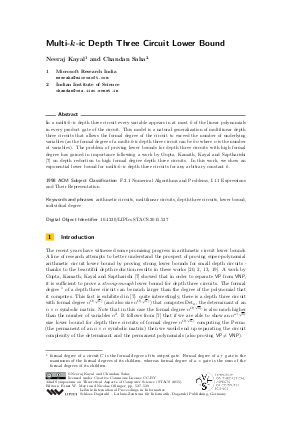Multi-k-ic Depth Three Circuit Lower Bound
Authors Neeraj Kayal, Chandan Saha
-
Part of:
Volume:
32nd International Symposium on Theoretical Aspects of Computer Science (STACS 2015)
Part of: Series: Leibniz International Proceedings in Informatics (LIPIcs)
Part of: Conference: Symposium on Theoretical Aspects of Computer Science (STACS) - License:
 Creative Commons Attribution 3.0 Unported license
Creative Commons Attribution 3.0 Unported license
- Publication Date: 2015-02-26
File

PDF
LIPIcs.STACS.2015.527.pdf
- Filesize: 0.66 MB
- 13 pages
Document Identifiers
Subject Classification
Keywords
- arithmetic circuits
- multilinear circuits
- depth three circuits
- lower bound
- individual degree
Metrics
- Access Statistics
-
Total Accesses (updated on a weekly basis)
0Document
0Metadata
Abstract
In a multi-k-ic depth three circuit every variable appears in at most k of the linear polynomials in every product gate of the circuit. This model is a natural generalization of multilinear depth three circuits that allows the formal degree of the circuit to exceed the number of underlying variables (as the formal degree of a multi-k-ic depth three circuit can be kn where n is the number of variables). The problem of proving lower bounds for depth three circuits with high formal degree has gained in importance following a work by Gupta, Kamath, Kayal and Saptharishi [7] on depth reduction to high formal degree depth three circuits. In this work, we show an exponential lower bound for multi-k-ic depth three circuits for any arbitrary constant k.
Cite As Get BibTex
Neeraj Kayal and Chandan Saha. Multi-k-ic Depth Three Circuit Lower Bound. In 32nd International Symposium on Theoretical Aspects of Computer Science (STACS 2015). Leibniz International Proceedings in Informatics (LIPIcs), Volume 30, pp. 527-539, Schloss Dagstuhl – Leibniz-Zentrum für Informatik (2015)
https://doi.org/10.4230/LIPIcs.STACS.2015.527
BibTex
@InProceedings{kayal_et_al:LIPIcs.STACS.2015.527,
author = {Kayal, Neeraj and Saha, Chandan},
title = {{Multi-k-ic Depth Three Circuit Lower Bound}},
booktitle = {32nd International Symposium on Theoretical Aspects of Computer Science (STACS 2015)},
pages = {527--539},
series = {Leibniz International Proceedings in Informatics (LIPIcs)},
ISBN = {978-3-939897-78-1},
ISSN = {1868-8969},
year = {2015},
volume = {30},
editor = {Mayr, Ernst W. and Ollinger, Nicolas},
publisher = {Schloss Dagstuhl -- Leibniz-Zentrum f{\"u}r Informatik},
address = {Dagstuhl, Germany},
URL = {https://drops.dagstuhl.de/entities/document/10.4230/LIPIcs.STACS.2015.527},
URN = {urn:nbn:de:0030-drops-49395},
doi = {10.4230/LIPIcs.STACS.2015.527},
annote = {Keywords: arithmetic circuits, multilinear circuits, depth three circuits, lower bound, individual degree}
}
Author Details
References
-
Manindra Agrawal, Chandan Saha, Ramprasad Saptharishi, and Nitin Saxena. Jacobian hits circuits: hitting-sets, lower bounds for depth-d occur-k formulas & depth-3 transcendence degree-k circuits. In STOC, pages 599-614, 2012.

-
Manindra Agrawal and V. Vinay. Arithmetic circuits: A chasm at depth four. In FOCS, pages 67-75, 2008.

-
Michael A. Forbes and Amir Shpilka. Quasipolynomial-Time Identity Testing of Non-commutative and Read-Once Oblivious Algebraic Branching Programs. In 54th Annual IEEE Symposium on Foundations of Computer Science, FOCS 2013, 26-29 October, 2013, Berkeley, CA, USA, pages 243-252, 2013.

-
Bruno Grenet, Pascal Koiran, Natacha Portier, and Yann Strozecki. The Limited Power of Powering: Polynomial Identity Testing and a Depth-four Lower Bound for the Permanent. In Proceedings of the 30th Foundations of Software Technology and Theoretical Computer Science (FSTTCS), pages 127-139, 2011.

-
Dima Grigoriev and Marek Karpinski. An exponential lower bound for depth 3 arithmetic circuits. In STOC, pages 577-582, 1998.

-
Dima Grigoriev and Alexander A. Razborov. Exponential complexity lower bounds for depth 3 arithmetic circuits in algebras of functions over finite fields. In FOCS, pages 269-278, 1998.

-
Ankit Gupta, Pritish Kamath, Neeraj Kayal, and Ramprasad Saptharishi. Arithmetic circuits: A chasm at depth three. In Foundations of Computer Science (FOCS), pages 578-587, 2013.

-
Ankit Gupta, Neeraj Kayal, Pritish Kamath, and Ramprasad Saptharishi. Approaching the chasm at depth four. In Conference on Computational Complexity (CCC), 2013.

-
Neeraj Kayal. An exponential lower bound for the sum of powers of bounded degree polynomials. Technical report, Electronic Colloquium on Computational Complexity (ECCC), 2012.

-
Neeraj Kayal, Nutan Limaye, Chandan Saha, and Srikanth Srinivasan. An Exponential Lower Bound for Homogeneous Depth Four Arithmetic Formulas. In Foundations of Computer Science (FOCS), pages 61-70, 2014.

-
Neeraj Kayal and Chandan Saha. Lower Bounds for Depth Three Arithmetic Circuits with small bottom fanin. Electronic Colloquium on Computational Complexity (ECCC), 21:89, 2014.

-
Neeraj Kayal, Chandan Saha, and Ramprasad Saptharishi. A super-polynomial lower bound for regular arithmetic formulas. In STOC, pages 146-153, 2014.

-
Pascal Koiran. Arithmetic circuits: The chasm at depth four gets wider. Theor. Comput. Sci., 448:56-65, 2012.

-
Mrinal Kumar and Shubhangi Saraf. On the power of homogeneous depth 4 arithmetic circuits. In Foundations of Computer Science (FOCS), pages 363-373, 2014.

-
Noam Nisan and Avi Wigderson. Lower bounds on arithmetic circuits via partial derivatives. Computational Complexity, 6(3):217-234, 1997.

-
Ran Raz. Multi-linear formulas for permanent and determinant are of super-polynomial size. J. ACM, 56(2), 2009.

-
Ran Raz. Elusive functions and lower bounds for arithmetic circuits. Theory of Computing, 6(1):135-177, 2010.

-
Ran Raz and Amir Yehudayoff. Lower Bounds and Separations for Constant Depth Multilinear Circuits. Computational Complexity, 18(2):171-207, 2009.

-
Sébastien Tavenas. Improved bounds for reduction to depth 4 and depth 3. In MFCS, pages 813-824, 2013.

-
L.\hspace0.04cmG. Valiant, S. Skyum, S. Berkowitz, and C. Rackoff. Fast parallel computation of polynomials using few processors. SIAM Journal on Computing, 12(4):641-644, 1983.

